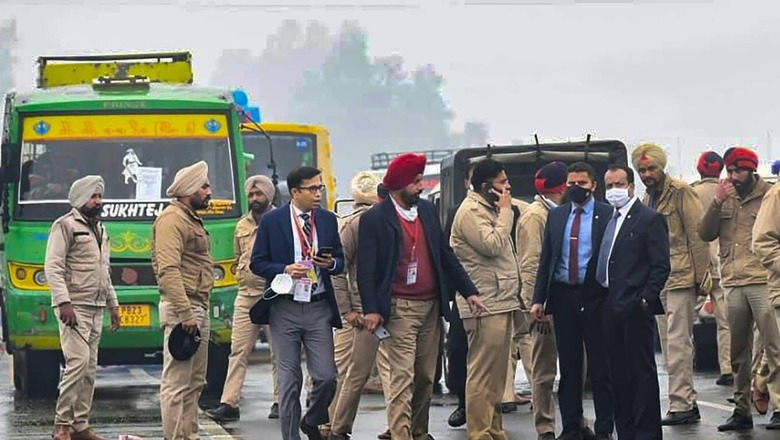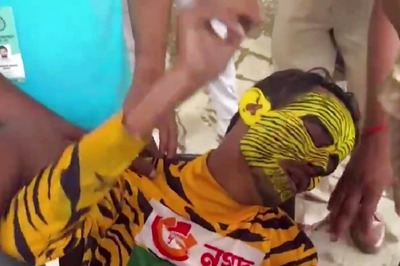
views
On January 6 last year, the world was rocked by images of rioters storming the United States’ Capitol, threatening the peaceful transition of power. One year later, almost exactly to the day, the Prime Minister of the world’s largest democracy sat abandoned on a small flyover in Ferozepur in Punjab, with only a handful of his personal security officers shielding him with their bodies. The political had just become personal. The safeguards that keep our constitutional system in place had been torn to bits.
In this country, we share power between state, central and local governments. We fight each other in elections, not by compromising each other’s security.
Anything could have happened in those 20 minutes. The Prime Minister was visiting a border state with a troubled history. Even worse, the state had just been rocked by protests in which the hand of anti-national forces could be clearly seen. We know that because they said so on camera. One of the protesters heading for the capital in late 2020 openly told the media that his people had assassinated Indira Gandhi, and Modi would be next.
The abdication of responsibility by the Punjab state government was near total, and almost certainly deliberate. Why was the route to be taken by the Prime Minister’s convoy not properly secured by the state police? The decision to travel by road was taken only two hours ago, due to bad weather conditions. Then who leaked the route to the protesters? According to the president of at least one of the protesting organisations, police itself tipped them off about it. This is borne out by visuals of police mixing freely with the protesters at the same time, enjoying so called ‘Chai ka Langar’.
The official response from the Punjab chief minister varied between denying responsibility and taking digs at the Prime Minister’s need for security cover. Lower down the ranks of the Congress party, the reactions were even more unguarded. Several party members expressed what can only be interpreted as squeals of delight. They were joined in this by most of the wider liberal ecosystem. The latter flooded the internet with hate filled ‘jokes’ and memes, clearly relishing the moment, fantasising about what could have been.
Both before and after he became Prime Minister, Narendra Modi has faced much abuse. Most of that abuse is unprintable, and it came from the highest levels of political parties, media and civil society. But the outright bloodlust, or at least the public expression of it, is relatively new. People uncovered an entire genre of videos simulating the assassination of Prime Minister Modi, allowing opponents to live out their sick fantasies in the digital world.
These videos were not from the dark underbelly of the internet. They were posted on mainstream platforms such as YouTube. They had already been online for a year, generating thousands of views and comments from like-minded individuals by the time anyone else noticed.
This radicalisation is not only a security threat, it also carries the risk of large-scale violence. Opponents of the Prime Minister, frustrated at not being able to defeat him politically, are now up for almost anything. It is not just opposition parties. The real fear is of unleashing forces that may be beyond their control. There is also a small group of television anchors, as well as internet personalities and ground-level activists, who are driving this radicalisation. They have discovered a small, but extremely loyal audience.
Day after day, they pamper this audience with wild conspiracy theories, from EVM tampering to ‘stories’ of the government building concentration camps for religious minorities. Day after day, they pump this toxic bubble full of paranoia, comparing present day India to Hitler’s Germany or Mussolini’s Italy. At any given point, they see at least seven different signs of fascism somewhere in India. They call upon their audience to resist. Their message is that anything goes, because their opponents are “saffron fascists”.
Along with their allies in global media, academia and the activist class, they build up this doomsday image of India across the world. They create a prism in which even normal day to day functioning of the Indian state is seen through the glass of “genocide” and “fascism.” How else do you explain terms such as “undeclared emergency” or “electoral autocracy?” These are self contradictory, and roughly similar to “meat-eating vegetarian” or a “square circle”. But for the highly radicalised, it all makes sense.
In India, we just had a movement where thousands of people blocked all routes to Delhi for over a year, and overturned a law passed by Parliament. How could anyone possibly believe that the right to protest is under threat in India?
The result is an atmosphere where the BJP, its leaders, workers and sympathisers, are completely dehumanised. The impact is most seen in Bengal, where murder and rape are now routinely used as instruments of subjugation against BJP workers. This is all rationalised as “fighting fascism”. Lower down the ranks of “liberals”, they welcome each such incident with great glee.
Opposition-run state governments have been quick to make use of this opportunity. The other day, the BJP state president in Telangana was thrown into jail on flimsy grounds. This kind of thing has been happening across the board, in Maharashtra, Jharkhand or Chhattisgarh. And now the Punjab government has gone much further, leaving India’s Prime Minister marooned on a flyover, at the mercy of “protesters”, only a few kilometers from the Pakistan border.
If you go back now and trace the arc of hatred, you can see it rising steadily since late 2019. Remember Shaheen Bagh protests and how a mother let her little baby, only a few months old, die in the cold of Delhi? What kind of radicalisation would make a mother go against the most primal of urges, and ‘sacrifice’ her baby? What kind of protest movement would glorify this act? This was followed by Delhi riots, storming of the Red Fort, mass violence against BJP workers in Bengal, and now directly threatening the Prime Minister’s personal security.
Like any cult, this mass radicalisation of “liberal” forces in India has two telltale features. First, it is based on ignorance. Those vowing to fight “saffron fascists” probably would not know that the original fascist party was an ally of the Catholic Church, with Vatican City itself being given by Mussolini to the Pope in 1929. Those on the Left comparing the BJP/RSS to Nazis also would not know that the Communists were actually military allies of Hitler for the first two years of World War 2. But facts matter little in an age of fake victimhood, where even the Mughal emperors are labelled “refugees.” The textbooks written by the old Left were already bad enough, but the new “liberalism” is worse.
Second, this radicalisation is big business. There are stray activists raising lakhs of rupees a month on the internet, selling conspiracy theories to a committed audience. Because the fringe pays, the fringe is served. Then, there are institutional investors, offering foreign scholarships and all manner of awards, junkets and honours for anyone willing to defame India. There is even a market for defaming hardworking Indian immigrants worldwide. With India’s reputation under attack, Indian immigrants risk being labelled fascists and “termites” unless they pay up for causes championed by the global liberal elite. And then, there is China.
When it comes to the threat of radicalisation, the media, and often even those on the Right, tend to relate it to a certain religious community. This however is a mistake. The Left has always been much more radicalised than any religious group could ever have been. There has been a brutal Left-wing insurgency going on in the heartland for 70 years. The principal actors and the provocateurs are exactly the same. They know how to turn political dissent into an insurgency. With just a few tweaks to suit the sensibilities of an urban audience, they are bringing this violence to cities. All in the name of “fighting fascism”.
They use the same line while provoking people in Bastar in Chhattisgarh, or in East Singhbhum district of Jharkhand, or in Gadchiroli in Maharashtra. What used to happen in Dantewada in Chhattisgarh could well happen in Delhi. We have to watch out.
Here is a question worth asking. What is being achieved by this mindless hatred against PM Modi and the delusions of those who think they are “fighting fascism”? Can it give one extra tap water connection in a country where only eight per cent of rural households had running water after 65 years of the republic? On the internet, the radical “liberals” fantasise about doing violent things with a tractor. But how does it help 60 crore Indians who depend on agriculture, a sector that has seen no reform in 70 years? After being in power for 10 years, the TMC government in Bengal recently announced that their “next” target would be economic development. Think about that statement for a second. For 70 years, the political forces in the state have been “fighting fascism” instead. What has come of it?
If you strip away the paranoia and the hatred, you will see what really happened on January 5 at Ferozepur. The state of Punjab stepped away from its duty to protect India’s constitutionally appointed head of government, due to political differences. Unlike terms such as “electoral autocracy” or “undeclared emergency,” we know exactly what it means to be a banana republic. And that is not supposed to happen here.
Abhishek Banerjee is a mathematician, columnist and author. The views expressed in this article are those of the author and do not represent the stand of this publication.
Read all the Latest Opinions here



















Comments
0 comment